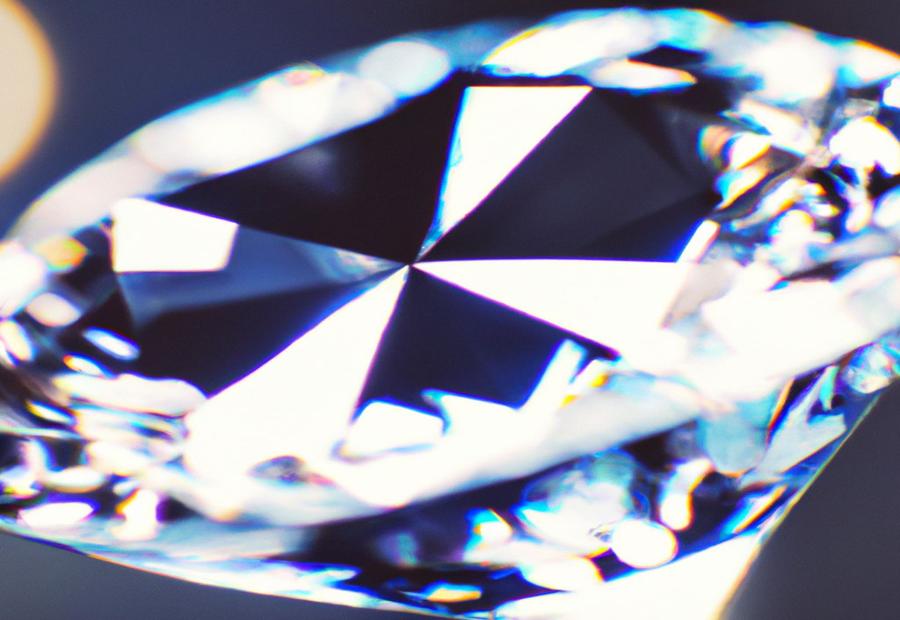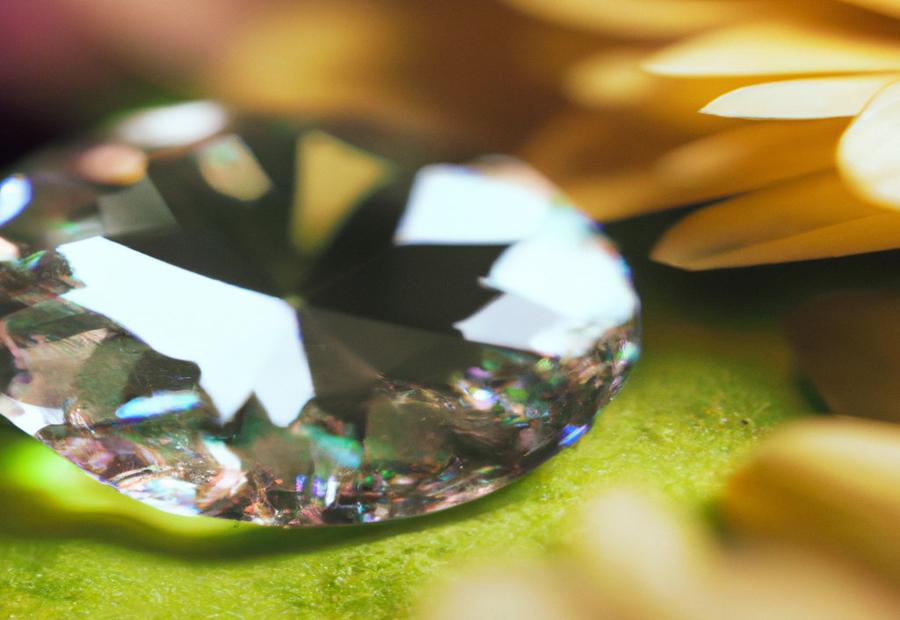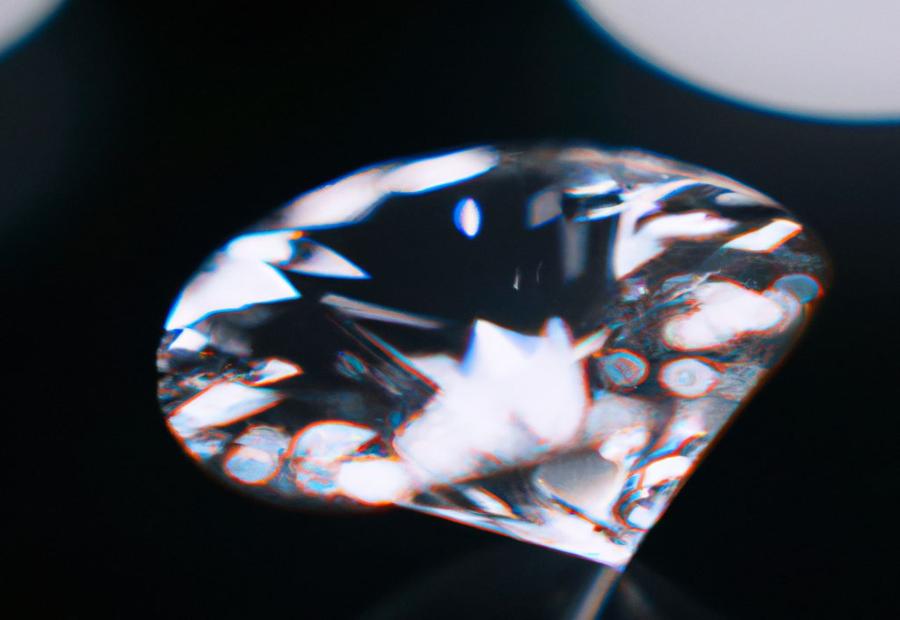Are lab grown diamonds more sustainable?
Key Takeaways:
- Lab-grown diamonds have a reduced environmental impact compared to mined diamonds. The Chemical Vapor Deposition (CVD) process used in their production results in a minimal carbon footprint and greatly reduces water pollution.
- Lab-grown diamonds offer ethical and social benefits. They are free from the ethical concerns associated with mined diamonds, such as forced labor and human rights abuses. Additionally, lab-grown diamonds provide economic benefits by creating jobs and supporting local communities.
- Despite their advantages, there are considerations and limitations to lab-grown diamonds. The lack of transparency in the industry raises concerns about the quality and origin of these diamonds. Additionally, lab-grown diamonds may have limitations in terms of size and color availability.
- When comparing sustainable diamond options, lab-grown diamonds stand out compared to both mined diamonds and vintage diamonds. They offer a more environmentally friendly alternative to mined diamonds and allow consumers to embrace sustainability without compromising on style or quality.
- Pandora’s commitment to sustainability and the industry’s perspective on sustainable diamonds reflect the growing demand for ethical and environmentally friendly options in the diamond industry. As consumers become more aware of the issues surrounding mined diamonds, the popularity of lab-grown diamonds is expected to increase.

Photo Credits: Www.Lab-Grown-Diamond-Earrings.Com by Sean Gonzalez
Lab-grown diamonds offer an intriguing alternative to traditional diamonds, but are they truly more sustainable? In this section, we’ll dive into the topic by exploring what lab-grown diamonds are and why sustainability has become increasingly vital in the diamond industry. By examining the environmental and ethical implications of lab-grown diamonds, we can gain a deeper understanding of the sustainability aspects associated with this modern approach to diamond production.
Lab-Grown Diamonds Defined
Lab-grown diamonds, also called lab-created or synthetic ones, are diamonds made in a laboratory instead of being mined from the ground. They have the same characteristics as natural diamonds, making them indistinguishable from mined ones.
The sustainability of the diamond industry is essential. Lab-grown diamonds offer a sustainable alternative to traditional mining which has profound environmental and social impacts. Choosing lab-grown diamonds helps with a more socially responsible and eco-friendly diamond production.
Lab-grown diamonds have a smaller carbon footprint than mined diamonds. In the CVD method used to make them, there is no need for extensive digging or land clearing, resulting in decreased energy consumption and less greenhouse gas emissions. This makes lab-grown diamonds an environmentally friendly option.
In addition, their water pollution is also lower than mined diamonds. Normal diamond extraction needs a lot of water, which can cause water pollution due to wastewater containing chemicals and sediments. Lab-grown diamond production doesn’t have this problem, making it a more sustainable choice.
Lab-grown diamonds have many benefits related to ethics, economics, and the environment. Ethically, they are not linked to human rights abuses or funds for armed conflicts. Economically, they create jobs in the lab-based diamond industry. Environmentally, they are more eco-friendly and have a more consistent and reliable supply chain than mined diamonds.
Vintage diamonds are an ethical choice because they are recycled, but they are not as sustainable as lab-grown diamonds. Furthermore, vintage diamonds may be scarce compared to lab-grown diamonds, which can be produced in larger quantities.
Lab-grown diamonds: A sustainable choice for a greedy industry.
Importance of Sustainability in the Diamond Industry
Sustainability in the diamond industry is a must. It impacts ecosystems, labor practices, and communities involved in mining. Lab-grown diamonds are an alternative that aligns with these values. They are created through advanced tech like Chemical Vapor Deposition (CVD), reducing the carbon footprint.
Lab-grown diamonds also minimize water pollution compared to mined diamonds. Mining can lead to runoff or chemical usage. In contrast, lab-grown diamonds require much less water and do not contribute to water source pollution.
The importance of sustainability also affects ethical and social factors. Lab-grown diamonds eliminate concerns around human rights violations and labor exploitation. Consumers can make informed choices based on ethical considerations.
Pro Tip: Seek out reputable sources and certifications for sustainable practices. Lab-grown diamonds: bling with sustainability!
Environmental Impact of Lab-Grown Diamonds

Photo Credits: Www.Lab-Grown-Diamond-Earrings.Com by Donald Harris
Lab-grown diamonds have gained significant attention as a potential alternative to mined diamonds, but what exactly is their environmental impact? In this section, we will explore the environmental implications of lab-grown diamonds, including the chemical vapor deposition process, their reduced carbon footprint, and the minimal water pollution associated with their production. With these key factors in mind, we can evaluate whether lab-grown diamonds truly offer a more sustainable choice for conscientious consumers.
Chemical Vapor Deposition Process
The Chemical Vapor Deposition Process (CVD) is a great way to make lab-grown diamonds. A sealed chamber is used to introduce a mix of carbon-rich gases. These gases are heated to very high temperatures. This causes the carbon atoms to separate and settle onto a diamond substrate, one layer at a time. This carefully crafted process results in the growth of an amazing diamond crystal.
The CVD process has several perks compared to other methods of lab-grown diamond production. Firstly, it can produce larger, high-quality diamonds with few inclusions. It also gives precise control over size, shape, and color of the diamond.
Moreover, it has a lower environmental impact than traditional diamond mining. Lab-grown diamonds are made in laboratories, so large-scale mining operations aren’t needed. This means no deforestation or habitat destruction. The CVD process needs less energy and water, resulting in a smaller carbon footprint and little water pollution.
Furthermore, lab-grown diamonds provide an ethical and socially responsible alternative to mined diamonds. These diamonds don’t involve human rights abuses, conflicts, or wars associated with traditional mining.
In short, the CVD process is a special and eco-friendly technique for making lab-grown diamonds. Manufacturers can create larger, high-quality diamonds. It also offers consumers a responsible alternative to mined diamonds.
Reduced Carbon Footprint
Lab-grown diamonds are produced using a process known as Chemical Vapor Deposition (CVD). No extensive mining or transportation is needed, resulting in reduced carbon emissions. These diamonds require less energy to produce than mined diamonds, and they also cause less water pollution. It is remarkable that these lab-grown diamonds emit up to 90% less greenhouse gases compared to conventional diamond mining practices. Consumers looking for a more sustainable option when it comes to purchasing luxury items like diamonds can opt for lab-grown diamonds, knowing that their environmental impact is minimized.
Minimal Water Pollution
Lab-grown diamonds are a great sustainable option to mined diamonds. They have many advantages, such as minimal water pollution. Mining diamonds has traditionally used large amounts of water. But the process of lab-grown diamonds, using Chemical Vapor Deposition (CVD), does not require any water at all.
CVD uses gases, like methane and hydrogen, which break down into carbon atoms to make diamond crystals. This method is much more eco-friendly than diamond mining. It reduces the need for lots of water, and there’s no water pollution.
Lab-grown diamonds also make for sustainable manufacturing. They don’t produce wastewater or release any substances that can pollute water.
Overall, lab-grown diamonds have a smaller carbon footprint and are better for the environment. Plus, they don’t compromise on quality or beauty. So, if you care about sustainability, lab-grown diamonds are a great choice!
Benefits of Lab-Grown Diamonds

Photo Credits: Www.Lab-Grown-Diamond-Earrings.Com by Philip Jackson
Discover the numerous benefits of lab-grown diamonds as we explore the ethical and social factors, economic factors, and environmental factors associated with these sustainable alternatives. Uncovering the facts and figures behind lab-grown diamonds, we’ll delve into how they contribute to a more responsible and eco-friendly approach to diamond production. Get ready to embark on a journey that highlights the positive impact of lab-grown diamonds across various facets of sustainability.
Ethical and Social Factors
Lab-grown diamonds offer several ethical and social advantages when it comes to sustainability.
- No Human Rights Issues: Lab-grown diamonds eliminate problems such as child labor and unsafe conditions connected with traditional diamond mining.
- Conflict-Free Sourcing: These diamonds provide a conflict-free option, not funding wars or civil wars.
- Positive Social Impact: People who pick lab-grown diamonds support companies that prioritize just labor practices and contribute to local communities.
- Transparency and Traceability: Lab-grown diamond producers offer details about the origin and production process, allowing customers to make wise decisions based on ethical considerations.
- Ethical Marketing: Companies that sell lab-grown diamonds appeal to customers who value sustainability and responsible sourcing.
Consumers looking for sustainable and socially-responsible products should opt for lab-grown diamonds. This move reflects changing views regarding luxury items.
For extra assurance about the ethical and social aspects of lab-grown diamonds, search for third-party certifications or verifications.
Economic Factors
The world of diamonds has economic factors that have an effect on the sustainability of lab-grown diamonds. These diamonds have become a more economically-friendly option than mined diamonds. Lab-grown diamonds are cheaper to get, due to the Chemical Vapor Deposition (CVD) process. This lowers the price for the consumer.
Manufacturers also have control of the supply chain, taking out middlemen and saving costs. The transparency and traceability of lab-grown diamonds keeps the quality high and the prices competitive.
Lab-grown diamonds also help the economy. They create job opportunities in the local area, which contributes to sustainable development. Skilled workers like technicians, scientists, engineers, and other professionals are needed for the growth of the industry.
Lab-grown diamonds are great for the planet and for people!
Environmental Factors
Lab-grown diamonds offer multiple environmental advantages over mined ones. For one, the CVD process used to make lab-grown diamonds has a lesser carbon footprint. This is because it requires less energy and no land excavation, as opposed to mining. Additionally, lab-grown diamonds cause minimal water pollution, due to its closed-loop system which recycles water.
The mining of diamonds involves clearing large areas of land, which leads to destruction of ecosystems and displacement of wildlife. In contrast, lab-grown diamonds do not require such practices, and help preserve natural habitats.
Lab-grown diamonds are also more energy efficient, when compared to traditional diamond mining. Mining and processing of diamonds need large amounts of energy, which produces greenhouse gas emissions and contributes to climate change. Lab-grown diamonds have a smaller energy requirement, thus, lower environmental impact.
Lab-grown diamonds are made using ethical and sustainable production methods. This eliminates human rights violations associated with diamond mining, such as forced labor and child labor.
In conclusion, lab-grown diamonds offer many environmental benefits over mined diamonds. These include reduced carbon footprint, minimal water pollution, preservation of natural habitats, lower energy consumption, and ethical production practices. All these factors together make lab-grown diamonds a more sustainable choice for environmentally conscious consumers.
Considerations and Limitations

Photo Credits: Www.Lab-Grown-Diamond-Earrings.Com by Joshua Young
Considerations and limitations surrounding lab-grown diamonds; from the lack of transparency in the industry to the essential limitations of these man-made gems.
Lack of Transparency in the Lab-Grown Diamond Industry
The industry of lab-grown diamonds is shrouded in a lack of transparency, which needs attention.
- It is hard for customers to understand the process and origin of these diamonds due to the obscurity.
- Companies’ practices and standards in making lab-grown diamonds are unclear, leaving customers unaware of any ethical or environmental issues.
- Transparency is key in ensuring responsible methods in the diamond industry. Without it, clients don’t trust lab-grown diamonds as a sustainable substitute for mined ones.
- Also, with no transparency, deceitful labeling of lab-grown diamonds is possible, making it difficult for customers to make knowledgeable decisions based on their values and preferences.
Limitations of Lab-Grown Diamonds
Lab-grown diamonds have their restrictions, which need to be considered when talking about sustainability. These can be categorised into three sections.
Firstly, a large issue with the lab-grown diamond industry is a lack of transparency. Unlike mined diamonds, which have regulations and certifications, lab-grown diamonds have no standardized grading systems or transparency in production methods. This makes it difficult for shoppers to decide wisely regarding the origin and quality of lab-grown diamonds.
Secondly, there are certain limitations connected to lab-grown diamonds. Though they do have a smaller carbon footprint than mined diamonds, the process of producing them in a lab is energy-intensive and may use lots of water. However, this water pollution is much less than normal mining practices.
Thirdly, there is a question about longevity and strength of lab-grown diamonds. Although they have the same physical properties as natural diamonds, people can be concerned about their long-term stability and endurance. Also, as technology improves and new ways to produce lab-grown diamonds are developed, there might be more restrictions which need to be looked at.
These limitations should not stop us from seeing the benefits and sustainability factors of lab-grown diamonds. Consumers and industry professionals should remember these limitations when making decisions about sustainable diamond choices.
To address these restrictions, here are some ideas:
- Firstly, improving transparency within the lab-grown diamond industry with standardized grading systems and certifications giving clear information on origin and quality.
- Secondly, investing in research and development to reduce environmental impact by increasing energy efficiency and reducing water usage.
- Lastly, studies to guarantee the durability and longevity of lab-grown diamonds, testing them in various conditions.
By putting these suggestions into action, people in the diamond industry can work on the limitations of lab-grown diamonds and boost their sustainability.
Comparing Sustainable Diamonds

Photo Credits: Www.Lab-Grown-Diamond-Earrings.Com by Henry Clark
When it comes to sustainable diamonds, the comparison between lab-grown diamonds and mined diamonds takes center stage. Join us as we explore the differences and benefits of both options. Additionally, we will delve into the intriguing world of lab-grown diamonds versus vintage diamonds, highlighting the unique aspects of each and the sustainability factors involved. Get ready to uncover the truth behind sustainable diamond choices.
Lab-Grown Diamonds vs Mined Diamonds
Lab-grown diamonds are becoming popular in the jewelry industry as a sustainable option to mined diamonds. They are created in a chemical vapor deposition process with high heat and carbon-rich gases – whereas mined diamonds are extracted through mining which is damaging to the environment.
Lab-grown diamonds also have a smaller carbon footprint. They emit fewer greenhouse gases, use less fossil fuels, and don’t cause water pollution. Moreover, no human rights abuses are involved in their production.
In addition, lab-grown diamonds bring economic growth by creating jobs and meeting consumer demands for sustainable and responsible products. Despite some limitations, they offer sustainability and ethical considerations that compete with vintage diamonds.
Lab-Grown Diamonds vs Vintage Diamonds
Lab-grown diamonds and vintage diamonds possess distinct features that can be compared in terms of sustainability. Lab-grown diamonds are made via the Chemical Vapor Deposition Process. This results in a reduced carbon footprint and minimal water pollution. In contrast, vintage diamonds are mined from the earth, leading to environmental damage and high carbon emissions.
Moreover, lab-grown diamonds offer ethical and economic advantages. They eliminate human rights violations and unfair labor practices connected to diamond mining. Plus, they are more cost-effective. Furthermore, they help to reduce deforestation and land disturbance caused by traditional diamond mining methods.
It is also worth noting that lab-grown diamonds provide transparency in the diamond industry. This is not attainable with vintage diamonds due to their complex global supply chains and potential conflict or blood diamond issues.
When weighing up lab-grown diamonds vs vintage diamonds based on sustainability, lab-grown diamonds demonstrate many benefits. From their decreased environmental impact to their ethical and economic advantages, lab-grown diamonds prove to be a more sustainable choice for responsible and conscious diamond buyers.
Pandora’s Choice and Industry Perspective

Photo Credits: Www.Lab-Grown-Diamond-Earrings.Com by Samuel Mitchell
Pandora’s Choice and Industry Perspective: Unveiling Pandora’s commitment to sustainability and gaining insights into the industry’s perspective on sustainable diamonds.
Pandora’s Commitment to Sustainability
Pandora, a big-name in jewelry, has made a dedication to sustainability. They understand the important role sustainability plays in the diamond industry. So, they are taking steps to make sure their diamonds are created in an ethical and environmentally-friendly way.
One of their solutions: lab-grown diamonds. This method, Chemical Vapor Deposition (CVD), significantly reduces the carbon footprint in comparison to traditional mining practices. Plus, it has less water pollution.
Lab-grown diamonds have a lot of positives when it comes to sustainability: they don’t contribute to human exploitation, they’re more affordable than mined diamonds, and they have great environmental benefits.
Pandora acknowledges transparency is key when it comes to lab-grown diamonds. This openness allows customers to get accurate information about the origin and production methods of their diamonds.
All in all, Pandora is leading the industry with their commitment to sustainability and providing customers with a more conscious option when buying diamond jewelry.
Industry Perspective on Sustainable Diamonds
Lab-grown diamonds have been gaining attention in the diamond industry for their sustainable nature. By using the chemical vapor deposition process, they reduce environmental impacts compared to mined diamonds. The industry views sustainable diamonds as necessary to address ethical, social, and environmental concerns.
The diamond industry has seen criticism for its negative environmental and human rights effects. Lab-grown diamonds show a shift towards more sustainable practices. CVD minimizes carbon emissions and water pollution. This perspective acknowledges the need for sustainable options that align with ethical and social values.
Lab-grown diamonds have economic advantages too. They are cheaper than mined diamonds, making them more accessible. More competition and diversification of product offerings result from this. The potential economic benefits further support the industry’s perspective on adopting sustainable practices.
Lab-grown diamonds have drawbacks. Some companies don’t disclose their production methods or origins of their products. This hinders consumer trust and raises questions about sustainability. Industry leaders recognize this and emphasize transparency to ensure credibility and accountability.
To foster a more sustainable diamond industry, transparency is key. Companies should provide detailed information about their production processes and sourcing methods. This builds trust and allows people to make informed decisions based on sustainability preferences.
Collaboration within the industry is also important. Companies should share knowledge and best practices to reduce environmental impacts and improve ethical standards. Industry organizations and associations can facilitate these collaborations and promote sustainable practices.
Conclusion
Lab-grown diamonds are becoming increasingly popular. It’s essential to analyze their sustainability. Lab-grown diamonds require less energy and water compared to mined diamonds. Plus, they don’t cause deforestation or pollute the environment.
Moreover, lab-grown diamonds have a smaller carbon footprint. There is no displacement of communities living near diamond mines either. Mining can often lead to human rights abuses and labor exploitation. But, this is not an issue with lab-grown diamonds.
Lab-grown diamonds are a great sustainable option for those concerned about the diamond industry’s environmental and ethical impacts. By choosing lab-grown diamonds, consumers can support an industry that reduces its negative impacts on the planet.
Some Facts About Lab-Grown Diamonds:
- ✅ Lab-grown diamonds are created in a laboratory using carbon molecules and are sustainable because the raw material needed to create them is non-depletable. (Source: Team Research)
- ✅ Lab-grown diamonds have the same physical and chemical characteristics as natural diamonds but cost less. (Source: Team Research)
- ✅ Lab-grown diamonds produce significantly less waste and consume less water and energy compared to mined diamonds. (Source: Team Research)
- ✅ The energy use and emissions from diamond-growing laboratories are negligible compared to the harmful emissions produced by mined diamonds. (Source: Team Research)
- ✅ Lab-grown diamond companies prioritize reducing damage to the Earth and providing environmentally friendly diamonds to consumers. (Source: Team Research)
FAQs about Are Lab Grown Diamonds More Sustainable?
Are lab-grown diamonds more sustainable?
Lab-grown diamonds are often marketed as a sustainable alternative to natural diamonds. They are created in a laboratory using carbon molecules and mimic the natural process of diamond formation. However, it is important to ensure that the company you buy from can back up their sustainability claims.
What are the advantages of lab-grown diamonds?
Lab-grown diamonds have several advantages. They cost less than natural diamonds and have the same physical and chemical characteristics. They also produce significantly less waste and consume less water and energy compared to mined diamonds.
What is the environmental impact of lab-grown diamonds?
The environmental impact of lab-grown diamonds can vary depending on the manufacturing process. If not produced properly, lab-grown diamonds may have a similar or worse carbon footprint compared to mined diamonds. However, as technology progresses, the growth process becomes more energy-efficient and the impact decreases.
How do lab-grown diamonds compare to natural diamonds?
Both lab-grown and natural diamonds have the same chemical and physical properties. However, lab-grown diamonds are created using sustainable artificial crystallized carbon, while natural diamonds are mined from the earth and can cause irreversible damage to the environment.
What are the environmental concerns with diamond mining?
Diamond mining has a negative impact on the environment. It causes soil damage, deforestation, air and water pollution, and land erosion. Mining operations also use hazardous substances and can lead to habitat destruction, biodiversity loss, and toxic contamination.
What are the most eco-friendly options for diamonds?
Vintage and antique diamonds are considered the most eco-friendly options. They involve no new environmental damage and contribute to resource recycling and reuse. Reusing vintage diamonds and jewelry pieces eliminates the need for new gem production and reduces the overall environmental impact.



Leave a Reply